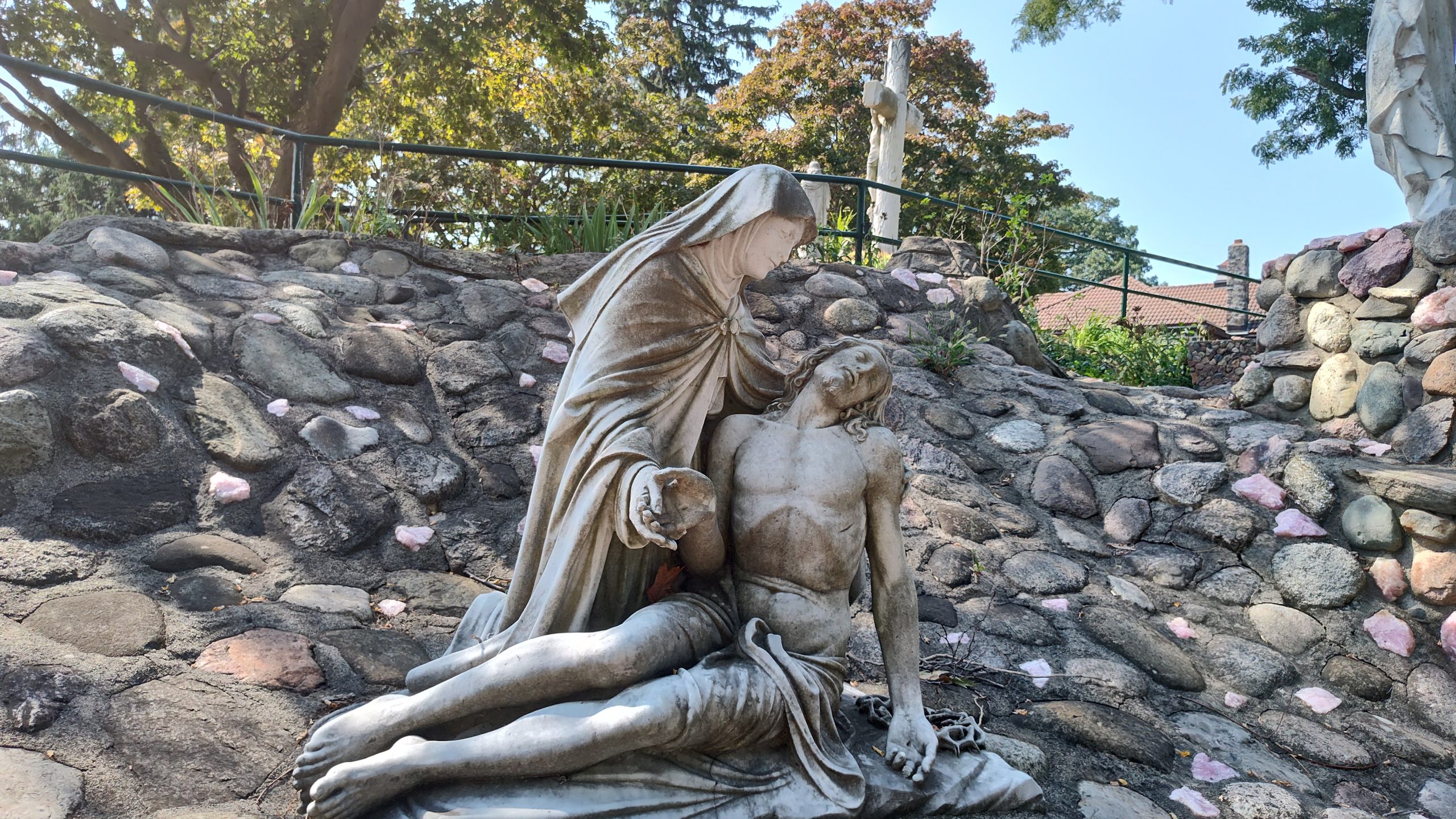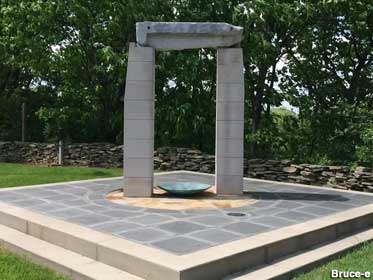Did you know that there are fourteen uniquely formed sculptures tucked along the bank of Iron Lake behind the St. Joseph Shrine? These remarkable, wet-cement styled pieces represent the story of Jesus carrying his own cross to his own crucifixion. How did this installation come to be? Who had built this meandering path of Trabajo Rustico sculptures? Join Chuck and I as we learn about this Michigan curiosity along US-12, south of Jackson.

The Pathway
“There’s suppose to be Trabajo Rustico statues . . . a bunch of them.” Chuck commented. “That looks like one over there.” He gestured past the graveyard to an altar-type structure built at the top of what appeared to be a cliff. Trabajo Rustico is Spanish and means “rustic work.”

“It looks like the same artists who made the seventeen bridges at McCourtie Park.” I surmised. We had visited a nearby park last year where seventeen bridges span Goose Creek. “I didn’t know that they’d made other sculptures, too.”
As we neared the Roman looking wall, we read the inscription sign. “This is Pontius Pilate’s palace. It’s the first one,” I recalled my Roman Catholic upbringing, “when Jesus had been condemned to death.”

We found an extensive stairway behind the first station and descended.

Soon we realized that we were going backwards through the display. We had been expected to follow the downhill pathway in the other direction.

As the lake rippled gently, these structures, set into the hill, allowed us to be immersed by the art. We were blocked from any roadway noise. Chuck and I silently went at our own pace from one sculpture to the next.


As we rounded the path we noticed more faux bois (French for ‘fake wood’) details originally known as Trabajo Rustico. (That’s Spanish for ‘rustic work.’)

Between 1932 to 1936 Ralph Corona and Dionicio Rodriguez had sculpted these wet cement renderings under the supervision of Leo Ouelette. The railings, steps and archways had been created from wet cement to resemble stone and timber.
“These were built when our parents were born.” I whispered in awe. Thinking about the generations who’ve walked this path.

Back at the top of the hill, I turned around to see the direction we should have traveled when we started our journey along the “Via Dolorosa.” The French term means, “Sorrowful Way.”

How Did The St. Joseph Shrine Begin?
Arriving in the 1850’s, just decades after Michigan had become a state, Reverend William Lyster felt at home among the rolling green hills alongside Iron Lake. This vista had reminded Lyster of his home in Ireland. With more Irish immigrants settling in the area, a church was built on this site, known as “Irish Hills.” The first Mass had been held inside this church in 1863.

Photo Credit: WFMK 99.1 article

Expansion of Irish Hills
It had been 1928 when Father Joseph Pfeffer had moved here from St. Mary’s in Manchester, England. At that time automobile travel along US-12, between Detroit and Chicago, had become routine. With St. Joseph church in “Irish Hills” marking a midpoint, opportunities for tourism brought about an expansion of the community.

Father Pfeffer oversaw improvements which had been fashioned in the Spanish Mission style with a red tile roof and mosaic interior designs. The seating had been expanded to fit three hundred-fifty attendees. In addition, Father Pfeffer had hired Corona and Rodriguez to complete fourteen stations of the cross over the next four years.
Previously, the stagecoach journey between Detroit and Chicago had taken five days. With the invention of the automobile, the length of travel had been shortened, but people still needed a break from riding in their cars.
Years later bus trips along this route would only take five hours and Irish Hills had been a stopping point. This community had wanted to offer an experience to remember. Many tourist sites, restaurants and lodging developed: a prehistoric forest, observation towers, Frontier Land, a Mystery Spot and a buffalo ranch.

Interstate 94
In the 1950’s the government had started to plan an extension of the Willow Run Expressway, which connected Ypsilanti and Belleville, to Detroit. This had been the catalyst for changing how we would travel across southern Michigan. By 1960 Interstate 94 had expanded westerly to New Buffalo. This diversion of traffic from US-12 had caused businesses to suffer. Many had shut down.

Photo Credit: Dan Cherry, Lenawee County History and Genealogy Facebook Page
Irish Hills Today
Even though several businesses have closed in Irish Hills, there’s still many sites to see! The Irish Hills Chamber of Commerce has a full community calendar of activities demonstrating how well this community continues to thrive.
St. Joseph Shrine stands ready for a self-guided tour. The church is a fully operating Roman Catholic congregation with Mass being celebrated on Saturdays at 5:00 and Sundays at 8:00 am and 11:00 am.

Photo Credit: Roadside America
Alongside St. Joseph Church is the “Au Gorta Mor” memorial. “The Great Hunger” monument by Kenneth M. Thompson which honors the one million Irish who had lost their lives due to the potato famine, which had been surrounded by oppression.
The Walker Tavern in nearby Cambridge Junction is renovated and open for tours three seasons of the year.

The observation towers are currently closed, but the group, “Oh These Irish Hills” are working to raise funds so they can begin restoration.
A newer business, Cherry Creek Cellars opened in 2003. They host wine tasting and have a cafe in an old brick, one room school house. It’s absolutely charming! I know, you are all shocked that I would point out a winery!

Photo Credit: Cherry Creek Cellar’s website
St. Joseph Shrine – A Secret Wonder
Personally, I found St. Joseph Shrine to be a secret wonder, tucked into the hillside of Iron Lake.
No matter which faith you may follow, these sculptures are impressive!
Thank you for coming along with us to our trip through time in Irish Hills. We encourage you to visit these sites! US-12 took us to many interesting, historical places. Check out our video! Stay curious and make memories!
Related Links:
The Walker Tavern had been a nearby stagecoach stop along US-12. It’s now a restored historical site. Here’s the story from our visit.
Here’s the article about our amazing visit to nearby McCourtie Park. There are seventeen bridges constructed by the same artists, Ralph Corona and another partner, George Cardoso.
Restless Viking merchandise is available!
Resources:
Diocese of Lansing website – St. Joseph Shrine
US 12 Heritage Trail online resource
WFMK 99.1 article “One Hundred Years “of Amusements in Irish Hills 1924 – 2024
Roadside America webpage
Historical Marker Database
Lenawee County History and Genealogy Facebook Page
Cherry Creek Cellers website





